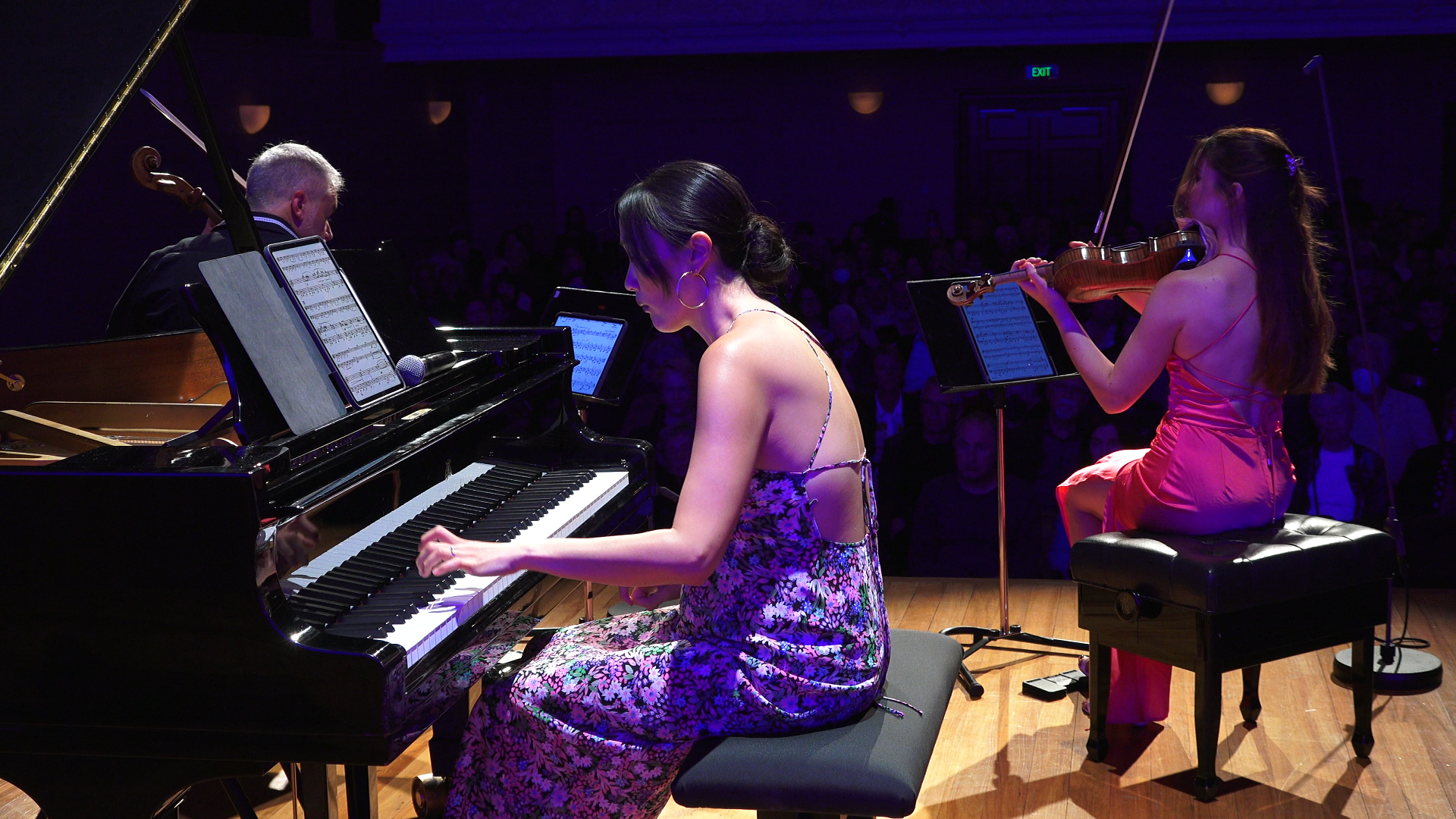Interfusions
27sep3:00 pmInterfusionsCMNZ Tour - Wellington
Event Details
InterFusions begins with Beethoven’s powerful and foreboding C minor trio, an impressive affidavit to his masterful talents. Then we teleport far from Europe into works that are steeped in the
Event Details
InterFusions begins with Beethoven’s powerful and foreboding C minor trio, an impressive affidavit to his masterful talents. Then we teleport far from Europe into works that are steeped in the diverse cultural backgrounds of their composers. Works by Greek-Canadian Christos Hatzis and Sri Lanka-Canadian Dinuk Wijeratne embrace a brand new work by New Zealander Salina Fisher. Her piece draws inspiration from the Japanese art of “Kintsugi”, where broken ceramic pieces are carefully reassembled, enhancing their inherent strength and beauty. We finish with Ravel’s famous Trio, bearing witness to the clear infusion of his French, Spanish, Basque and Roman Catholic influences.
Beethoven: Piano Trio in C minor, Op 1, No 3
Christos Hatzis: Old Photographs
Salina Fisher: Kintsugi (new commission)
Dinuk Wijeratne: Love Triangle
Ravel: Piano Trio in A minor
DATES & LOCATIONS
Wellington: Sunday, September 27, 3pm – St. Andrew’s on the Terrace – TICKETS
Rotorua: Thursday, October 1, 7:30pm – The Harvest Centre (door sales only)
Waikanae: Sunday, October 4, 2:30pm – Waikanae Memorial Hall (door sales only)
Christchurch: Wednesday, October 7, 7:30pm – The Piano – TICKETS
Lower Hutt: Thursday, October 8, 7:30pm – St. Marks Church, Woburn Road (door sales only)
Whangarei: Saturday, October 10, 7:00pm – Old Library Building Arts Centre (door sales only)
Warkworth: Sunday, October 11, 4:00pm – Warkworth Town Hall – TICKETS
Presented by CMNZ in association with Aroha Music Society, Chamber Music Wanganui, Expressions Whirinaki, Motueka Music Group, Rotorua Music Federation, Waikanae Music Society Inc., Wellington Chamber Music Trust, Whangarei Music Society.
Duration approx. 2 hours, including interval
Ticket prices vary, please contact venue
Time
September 27, 2020 3:00 pm UTC+12:00(GMT+00:00)
Location
St Andrew's on the Terrace
Organizer
Programme Notes
LUDWIG VAN BEETHOVEN (GER; 1770-1827): PIANO TRIO NO. 3 IN C MINOR. OP.1 NO 3 (1794), C. 28’
- Allegro con brio
- Andante cantabile con variazione
- Menuetto quasi Allegro
- Finale. Prestissimo
“Though I had some instruction from Haydn, I never learned anything from him.”
So Beethoven claimed!
He was 24 years old when he decided he was finally ready to unleash his opus 1 onto the world. Three piano trios which were by no means the first things he had written, but which he was finally happy enough with to announce himself not just as a pianist, but as a composer, ready to astonish the world.
He had been in Vienna for two years then, having just missed Mozart but armed with a letter of introduction to Haydn, who had been teaching him counterpoint. Haydn found Beethoven bewildering. He was so wayward, refused to do anything by the book: his other teachers had the same complaint. Albrechtsberger remarked “He will never do anything in a proper decent style”. As for Beethoven, he found Haydn hopelessly old fashioned, a creature of the court, a composer of a different century. But he was still Joseph Haydn, the greatest composer in Vienna. So you can imagine Beethoven’s hurt when it came to the concert. Haydn was there, of course, and when everybody rushed for his opinion “he said many pretty things about them”, apparently, in the words of someone who was there: but he also advised Beethoven to withdraw this one, the third and last, from publication. But this was the best! Beethoven was outraged. He even wondered if Haydn was being malicious in saying so – if in fact he was jealous. It soured their relations for a while.
In fact, Haydn simply feared that the public would not like it. It was so newfangled, so audacious, which is the astonishing thing about this very first opus. All those genius quirks that we associate with Beethoven are there already. There’s that brow-furrowed opening before the sun breaks out, contrasting emotional and dynamic extremes – pushing the instruments to their limits and sonata form to its limits, as well. He develops that first movement way beyond what Haydn would have considered polite. Variations follow, sweetly introduced by the piano, brilliantly exploiting the textures of the instruments: fancy one whole variation where the strings play nothing but pizzicato. And the totally virtuosic piano writing, and that snappy wrap-up, and those divinely lyrical tunes. Then a minuet that’s suddenly not a minuet. Those accents! You can’t dance to that. And it all ends in a stormy finale that makes countless unnerving turns before dying in a whisper – no wonder Haydn was alarmed. He needn’t have been: all three trios were instantly taken up by amateurs and professionals alike. Beethoven was on his way.
CHRISTOS HATZIS (GRC/CAN; B. 1953): CONSTANTINOPLE: OLD PHOTOGRAPHS (2000), C. 5’
“Staggeringly beautiful … one of the most talked about compositions of the decade… possibly the most talked about classical composition in Toronto’s history”… the composer, Christos Hatzis, was born in Greece but settled in Canada as a professor at the University of Toronto, and has won many awards for music which has its roots in his Byzantine heritage but casts widely among traditions that range from the Canadian Inuit to 20th century modernism, jazz, tango…. all of which you’ll hear in here. It’s the seventh and penultimate movement of a multi-media work for middle eastern singer, electronics and piano trio that took the world by storm – Constantinople.
SALINA FISHER (NZ; B. 1993): KINTSUGI (2020 NEW COMMISSION), C. 5’
Kintsugi is the ancient Japanese art of repairing broken pottery with gold. All of the broken pieces are carefully joined back together with gold-dusted urushi (lacquer). Rather than hiding the damage, kintsugi celebrates all the cracks or ‘scars’ for the unique history that they represent. The object is more beautiful for having been broken.
The composer writes: “I am personally drawn to kintsugi as a metaphor for embracing ‘brokenness’ and imperfection as a source of strength. This piece for piano trio is my expression and exploration of kintsugi, and involves musical fragmentation, fragility, mending, and finding beauty in the cracks. While writing this piece, I was very fortunate to meet Wellington-based Japanese ceramicist and kintsugi practitioner Kumiko Jacolin. I am grateful to Kumiko for her work and our discussions on Japanese philosophy in ceramics that have been influential in my creative process.”
Since recently graduating with a Master of Music in Composition from Manhattan School of Music, New York, Salina has been appointed Composer-in-Residence at New Zealand School of Music – Te Kōkī, Victoria University of Wellington, 2019-2020.
DINUK WIJERATNE (LKA/CAN; B. 1978): LOVE TRIANGLE (2013), C. 16’
Classic genre-bending deliciousness from a composer who is very much a product of cross cultures himself. Born in Sri Lanka, growing up in Dubai, trained in England and the USA and now based in Toronto, Dinuk Wijeratne made his debut at Carnegie Hall with Yo Yo Ma’s Silk Road Ensemble and has performed all over the world as a conductor-pianist-composer, bewitching audiences with his particular brand of fusion and equally at home in collaborations with symphony orchestras and string quartets, tabla players and DJs, in places as diverse as the North Sea Jazz Festival and the Berlin Philharmonie. It’s a style that fuses funky jazz riffs with Indian tabla-like dance rhythms, tonal clusters, extended instrumental techniques, native North American and Middle Eastern influences, all bristling with the energy of a coiled spring … and it keeps winning awards, including a Juno award and a Nova Scotia Masterworks nomination for this very trio.
The composer says about this piece: “This music evolved rather rhapsodically from two distinctive features: the Middle Eastern-inspired melody heard in the strings at the outset, and the underlying rhythmic pattern inspired by a seven-beat Indian Classical ‘time cycle’. It also attempts to integrate a Western Classical sense of structure with three very improvisatory cadenzas from each instrument – the musicians and I are aiming for an effect akin to that glorious ‘out-of-time’-ness that occurs when an Arabic Oud solos over the unyielding fixed groove of the band.”
MAURICE RAVEL (FRA; 1875 – 1937): PIANO TRIO IN A MINOR (1914), C. 26’
- Modéré
- Pantoum (Assez vif)
- Passacaille (Très large)
- Final (Animé)
“They say I’m dry at heart. That’s wrong. I am Basque! Basques feel things violently but they say little about it and only to a few.”
This mysterious, elusive, passionate, trio is the work that Ravel was writing when Europe plunged into war. August 1914: he had in fact been working on it for some time – six years, in fact, with his usual fastidiousness – and in earnest since March, taking it with him to St Jean de Luz in Basque country and telling his teacher, Gédalge, “I’ve written my trio. Now all I need are the themes.” What happened instead was the German invasion of France, which gave him all the impetus he needed. He rushed to finish it, “working on the Trio with the sureness and lucidity of a madman”, and immediately tried to enlist as a bomber in the French Air Force. He was rejected: his age (39), and something minor to do with his heart. But he continued applying, went through his training, until finally he was accepted as a truck driver into the 13th Artillery Regiment, driving munitions at night right on the front, under constant German bombardment, until the end of the war. Corresponding with Vaughan Williams throughout this period, he writes in June 1915: “It seems years since I left Paris: I have had moving, painful, and dangerous enough times to find it astonishing to come out of here still alive.”
One fancies that you hear some of the threat facing Europe – and Ravel personally – in the largely dark, elusive colours of this trio. But for him it was also a celebration of life, a tribute to his Basque heritage of which he was tremendously proud: his mother was Basque, and her own great love of the Basque language and folk songs had a tremendous influence on his life and music. You can hear the rhythm of the zortziko, a very distinctive Basque folk dance, in the first movement – rhythm is key to this whole work, the second movement Pantoum being based on a traditional Malaysian verse form in which the second and fourth lines of a stanza become the first and third lines of the next. The third movement is a passacaglia on the piano’s opening eight-bar theme in the bass: and the final animé, constantly alternating between time signatures over magical harmonics and trills drives towards a brilliant coda. And that, of course, is only part of Ravel’s genius. The inexorable weaving together of melodies and harmony: the shimmering atosmphere; the classically perfect form. At first, it attracted little notice – France was in chaos – but that didn’t last for long. Jean Marnold writes, on its publication in November 1915, “There is little in the musical repertoire that one can compare it with… No matter whether in writing technique, harmony, polyphony, rhythm or inspiration, everything is new, personal, totally original, and simple – of the simplicity which we are born with, which is our secret, and which constitutes the perfection of our masterworks.”
Programme notes by Charlotte Wilson


